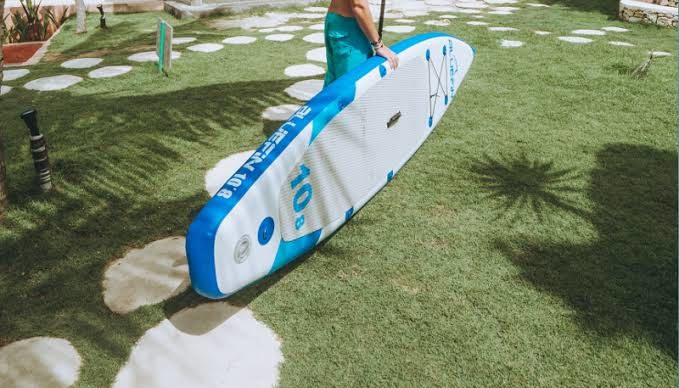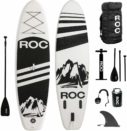The longer we use them, inflatable SUP’s tend to get dinged, stained, scratched, and dirty. To keep your board strong, clean, and functioning as it should, here are a few steps to follow. We also answer an important question that all ISUP users have; is it OK to leave an inflatable sup inflated?
Below we’ll take a look at how to properly clean your paddleboard, store it, and repair any minor leaks or tears.
Proper Cleaning
Step 1: Rinse the entire board with fresh water to remove dirt, gravel, and debris. You don’t have to rinse your board after using it each time if you are paddling in freshwater unless you want to clean off debris quickly. But if you’re paddling in saltwater, it’s important to rinse your board with fresh water to remove the salt. Salt can corrode the material and weaken the seams over time. Cleaning with fresh water will prolong the life of your board.
Step 2: To clean the PVC material on your ISUP, it’s best to use any natural biodegradable cleaner. It’s also safe to use any natural soap that you use to clean around your home. Anything without chemicals should be fine to use. However, if your cleaner isn’t enough to do the trick, one that is quite effective plus environmentally friendly is Onit Pro Blue Goo. Blue Goo also helps to protect the material from UV rays. When cleaning the traction pad, be sure to scrub very gently so as not to shred the pad.
Step 3: Then, rinse thoroughly with fresh water after cleaning to remove all soap residue. After cleaning your board or after paddling, let the board dry completely. It’s a good idea always to bring an old towel along so you can give the board a quick towel dry. It’s best to let your board dry off as much as possible before packing away. Leaving it wet will promote the growth of bacteria and mold as well as weaken the seams.
Storage
One of the most advantageous features of inflatable stand up paddleboards is that they can pack away into a storage bag or backpack and be stored in a small space. When the board is dry, deflate it, take off the fins and the leash, roll it up and pack it away inside the storage bag. It’s also best to keep the bag stored away from the elements and out of direct sunlight.
When packing away your paddleboard, a point of caution is not to roll the board too tightly. People often roll the board as tight as possible to put it into the backpack storage bag. However, it is better for the seams if the board is rolled ‘loosely’ as opposed to tight.
Leaving the Board Inflated
Many people ask whether they can leave their board inflated instead of deflating it after each use. The short answer is yes; you can, but please store it away from the elements in a cool area out of direct sunlight and ideally off the ground. All inflatable paddle boards will lose some air pressure over time if the board is left inflated day after day. Therefore before taking the board out again, it would be wise to quickly check the air pressure with the gauge on your pump as you may need to top it up.
Overall, inflatable SUP’s are incredibly delicate despite being able to take our weight and braving activities we undertake in fresh and saltwater. So to make sure that they last as long as they should, it is essential to know how to take care of them properly. Our guide covers pretty much all you need and extra tips for when you want to leave your board inflated. From the proper way to clean your board to storing it, you should now be fully equipped to take care of your paddleboard.





